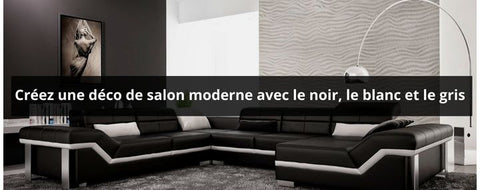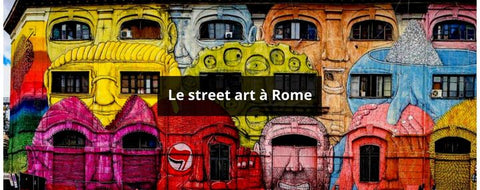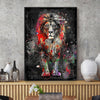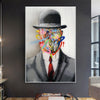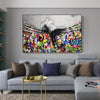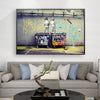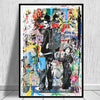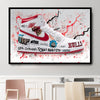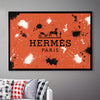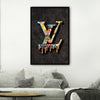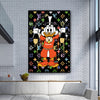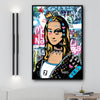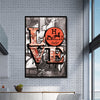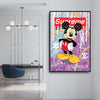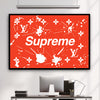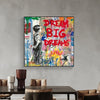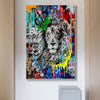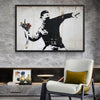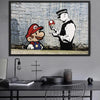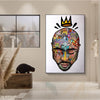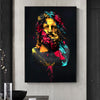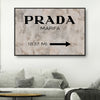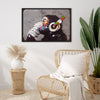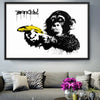
Who created Street Art?
Are you drawn to the world of Street Art? Does this new decorative trend intrigue you? Do you see it emerging all around you, or is it even already present on the walls of your friends' living rooms? Do you want to know who created Street Art?
The graffiti that began appearing on the sides of train cars and on walls is certainly one of the earliest examples of Street Art. It was the work of gangs in New York during the 1920s and 1930s.
If you'd like to learn more about this world, we are true experts in the field. In this article, we will cover the following:
- Where and when did Street Art originate?
- Its origins: a brief explanation of the emergence of Street Art in France.
- How could we simply define Street Art?
- What techniques are used? Graffiti, stencils, etc...
Rest assured, once you have finished reading, you will know everything about the emergence of this new decorative trend: Street Art!

I) Where and when did Street Art originate?
In this section, we will distinguish the birth of Street Art from its emergence in Europe. The initial focus will be on the USA, and then we will examine how and who contributed to the "birth" of Street Art in France.
A) The Origins of Urban Art
The term "graffiti" often refers to works of art on city walls and/or subway lines. It was a movement popularized in the late 1960s and also in the 1970s. One of the earliest forms of graffiti was "tagging," which involved using elaborate typography to tag the artist's name on the walls of buildings and/or subway cars.
Artists earned extra points by tagging inaccessible locations, often at great heights, and taggers competed to outdo their rivals in ingenuity. This island group honed its skills by mastering spray paint control and developing its own unique typographic marks.

From the outset, this art form was intended to be transgressive : in a world dominated by global branding, graffiti challenged the power of commercialism and government infrastructure. Street art was often viewed negatively by politicians and wealthier communities because it was associated with gang culture. However, it's worth noting that the artworks also served as a means for groups of disenfranchised citizens to express their discontent with society.
B) Who is the father of Street Art in France?
Banksy, the anonymous superstar of British, and indeed global, street art, was partly inspired by Blek le Rat. Yes, the famous Banksy was indeed inspired by a French street artist.
Born Xavier Prou, 69, Blek developed a stencil style and adopted the rat as the "characteristic" image of his art. Blek, who was born in the western suburbs of Paris, told us in an interview how his street art career began.
"I took a trip to New York in 1972 and saw the first graffiti in the subway and on the street. I was very quickly impressed."
At the time, an art and then architecture student, it wasn't until 1981 that he truly "digested" what he had seen there! For his architecture degree, he participated in the creation of an adventure playground, a play park for teenagers. He explained that this type of facility had been created for young people in the suburbs since the post-war period, to prevent them from playing in dangerous places like bombed-out buildings during their free time.

"Children would steal paint and brushes from supermarkets and go paint on the walls of the park. They didn't know how to paint, they painted anything, things like houses, and it reminded me of what I had seen in New York. I was already a painter and I loved art, so I thought I would make a name for myself by doing the same thing on the walls of Paris."
His first attempts took place in a vacant lot where he tried out New York-style graffiti. "It was difficult, I didn't have the technique and it was hard to get hold of spray paint cans. I used car paint."
He then took to poking rats , which earned him his nickname. "Paris has always been full of rats," he told us. "And at the time, there were a lot of them in the 14th arrondissement, so I thought it was fun to paint them all over there."
As for "Blek le Rat", his name comes from Blek le Roc, a character from a comic strip series from the 1950s-1960s that he liked.
II) How do we define Street Art?
Street art is a unique art form found only in the street. Many people don't recognize it as art, and sometimes associate it with vandalism . In the world of street art, as we know it, the following terms are commonly used: graffiti, stencil, sticker art, and yarn bombing.
Through this art form, various street artists seek to express their beliefs. In their artwork, we can find their ideologies and emotions, both positive and negative. Most street artists are politically engaged. And wherever they express their art, they choose the street as their medium because it's how they can reach the widest possible audience. Some of the most famous street artists have chosen to remain anonymous , such as Banksy and Alec Monopoly.

III) What are the techniques of Street Art?
Together, in this final part, we will see how to define the various techniques best known in the world of street art.
A) Tagging
"Tagging" refers to the simple act of applying a "label" or signature to a surface, although these signatures can be very complex in their content and calligraphic appearance. For example, the famous artist Jean-Michel Basquiat used the tag SAMO to sign his works.
B) The Throw-up
A "throw-up" is larger than a "tag" and is usually painted very quickly, using a maximum of two to three colors.
C) The Stencil
"Stencil graffiti" , which uses cutouts for the rapid creation of complex shapes, appeared in the early 1980s, thanks to the Parisian graffiti artist Blek le Rat and was later copied by the great Banksy !

D) The Masterpiece
A "piece" (masterpiece) is a much more elaborate "tag," with greater complexity and a wider range of colors. Although these "pieces" are often very impressive as visual artworks, they can be erased in minutes by a rival graffiti artist with a simple "throw-up."
E) The Blockbuster
A "blockbuster" or "roller" is a large, block-shaped work often done with a paint roller and executed simply to cover a large area in order to prevent other street artists from painting on the same wall.
F) Top-to-bottom
"Top-to-bottom" graffiti art covers an entire subway car. It became popular thanks to subway graffiti artists in New York during the 1970s.
G) The Wildstyle
"Wildstyle" is a more elaborate form of graffiti, usually marked by intersecting letters and connecting points, creating a more complex, sometimes indecipherable, "tag" or image.
Let Street Art into your home
Now that this new decorative trend holds no secrets for you, you probably understand why it's so exciting!
Indeed, there's nothing quite like urban art to bring joy and meaning to your interior decor. Thanks to the pieces we offer, you won't need to break the bank on an authentic artwork or one bought at auction. For around a hundred euros, you can let your personality and tastes shine on your walls!
See you soon.
The Lofty Trend Team.





